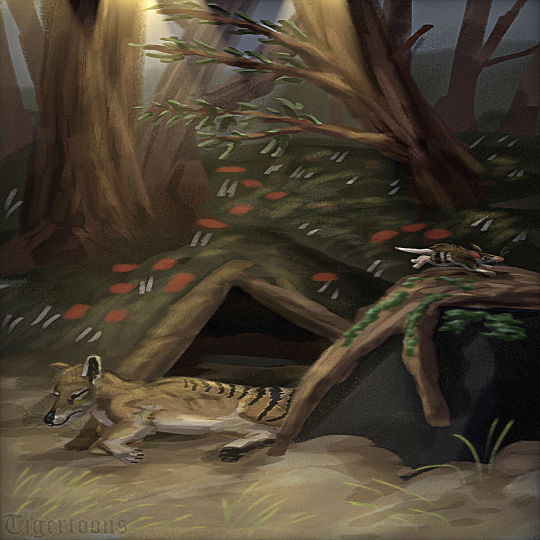Don't wanna be here? Send us removal request.
Text
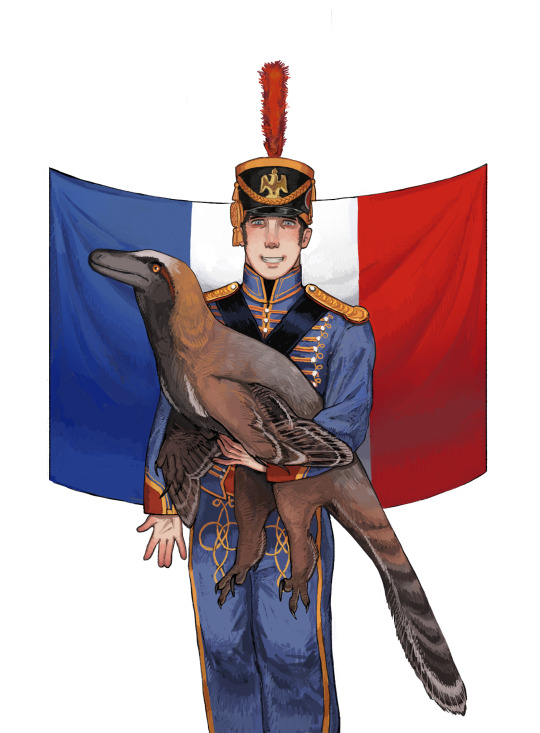
Found out that pyroraptor are found in southern France and suddenly have a lightbulb above my head (aka excuses for me to draw napoleonic soldier and dinosaur together)
254 notes
·
View notes
Text

Tales of Earth
4. Amplectobelua
Exhausted after the end of the mating season Amplectobelua is looking for a fresh meal. Having spent the previous week on an intricate mating ritual, the male amplectobelua returns to hunting. The season took longer than usual leaving the predator exhausted with little life reserves, but instincts push him forward. Unfortunately for him, his intricate courting carapace is yet to mold, only detrimenting his situation. The coloration will change with time, time which he no longer has.
Hunger pushes him to the unusual places. He flows to a sponge reef. It is abundant in life, but the narrow spaces are a problem for the big predator. After a few futile attempts, amplectobelua stops to regain strength while waiting for some critter to make a wrong move.
Suddenly a slight movement of water of water indicates an upcoming danger. Amplectobelua doesn't see any concurrents approaching, but the threatening feeling doesn't go away. The gravel underneath slowly shakes, rising dim clouds of sand. The earth itself is moving. With this growing rumbling, it doesn't take long for the reef to start falling apart. Sponges that took years to grow fall in minutes. As it happens, the creatures inhabiting this place scatter to avoid being buried alive. A panicking nectocaris rushes upward. A perfect opportunity for the predator. The amplectobelua is used to hunting hard shelled prey, but he won't mind an easy meal.
One nectocaris isn't enough for amplectobelua to regain its strength. The scattering habitans of the reef are plentiful and he won't stop at the first one. In the hunt amplectobelua completely ignores the sense of danger.
With every new attack the predator slows down. This time it is not the fatigue. The Cambrian sea ecosystems are fragile. In these warm waters oxygen levels are very uneven. Ususally, this is not a problem. But now, the erupting volcano moves the earth, easily breaking the equilibrium. With both gases from the eruption covering the ocean and the low-oxygen waters moving from the depth the reef slowly chokes. Not registering what is going on the creatures that didn't get far enough from the debris stop moving. Among them is amplectobelua. As it slowly fails down the ash from the eruption covers the corpse, preserving it for millions of years to come.
#tales of earth#digital art#sketch#drawing#artists on tumblr#paleoart#cambrian#paleoblr#nectocaris#anomalocaris#prehistoric#radiodont
8 notes
·
View notes
Text
Appreciation post for all the beginner artists who work hard despite the AI looming over us. You are fabulous. You are precious. Keep up the hard work, you are needed.
64K notes
·
View notes
Text

Lambeosaurus walking through thick vegetation. 20 day of Maysozoic !
107 notes
·
View notes
Text

In a world where the Cambrian explosion never ended, Wiwaxia has conquered land during the Neo-Permian Epoch. Its spiked armor now protects it as it forages among towering, iridescent flora—plants evolved in tandem with its unique physiology. Together, they form a radiant, co-evolved biosphere untouched by vertebrates.
🪱 Wiwaxia lux-spinosus
An evolved descendant of the Cambrian-era Wiwaxia, Wiwaxia lux-spinosus is a mid-sized terrestrial grazer adapted for low-light forest floors dominated by primitive, bioluminescent flora. Its defining features include iridescent dorsal spines (used for both camouflage and communication), a soft but armored segmented body, and a flexible, elongated snout capable of delicate browsing and chemical sensing.
W. lux-spinosus exhibits a degree of behavioral complexity: it forms small, slow-moving herds and shows rudimentary social signaling via spine coloration and bioluminescent pulses.
🌿 Noctiherba iridescens
A dominant flora of the Neo-Permian understory, Noctiherba iridescens is a tree-like plant with dark, thick leaves exhibiting striking iridescence. These leaves absorb limited ambient light and reflect excess wavelengths as shimmering blues and purples—possibly as a defensive mechanism or a form of visual signaling. Instead of flowers, it produces small spore-cones protected under curled bracts.
The plant’s roots exude nitrogen-fixing compounds, supporting surrounding soil health in nutrient-poor volcanic substrates.
カンブリア爆発が終焉を迎えなかった世界。ネオペルム紀の地上では、ウィワクシアが進化し、光沢ある植物群と共に生きている。その棘状の装甲は捕食者から身を守り、植物はこの生物と共に独自の進化を遂げた。脊椎動物が存在しない、輝く共進化の生態系がここにある。
20 notes
·
View notes
Text

Tales of Earth
3. Nectocaris
A cool tidal stream brings nutrients back from the depths to the seashore. The shores of the sole ocean, Panthalassa, bristle with life in all shapes and colours. Having first appeared over 100 million years ago, sponges rose to prominence at the beginning of the Cambria, becoming the main reef builders of that era. The most successful group is Archecyacha. The secret of their success is the mineral skeleton which persists after their death. This allows every new sponge to build on the legacy of the previous one. Generation after generation, vast reefs are formed.
The appearance of those reefs has given the safe haven for all kinds of small animals. The ubiquitous sponge carcasses provide abundant hiding places from large predators.
This nectocaris has spent its whole life in these waters. Its soft body allows it to flow easily through the narrowest spaces in search of food as it does now. But this time there's a problem. Two stalked eyes detect the shadow of a slowly approaching predator. Isoxis is small enough to maneure between the sponges which places it on the top of the food chain
Instincts tell that it is too late to hide from being grabbed by two arthropod appendages. In the sudden move, Nectocaris starts to move forward.
The predator stops. Something tells it that this is not prey to be messed with. The colouration of the nectocaris does its best to mimic the segmented body of a small species of radiodont — the family that includes the infamous Anomalocaris. As it begins to wiggle, the resemblance becomes too uncanny for the predator, which backs down in search of an easier prey.
#tales of earth#artists on tumblr#digital art#sketch#drawing#paleoart#cambrian#nectocaris#archaeocyatha#reefs#speculative biology#paleoblr#prehistoric
21 notes
·
View notes
Text
Unlike its portrayal in a lot of modern media, the colonization of Laramidia quickly revealed that despite their fearsome appearance, adult Tyrannosaurus are not aggressive towards humans.

This is partly due to their huge size simply making us too small to be worth the effort, and also the aforementioned fact that we're completely alien to their world and they simply don't recognize us as a potential prey item and as predators who need to be able to hunt in order to live they're wary of messing with something they don't know that could potentially injure them. As a result this has led to a growing perception back in the modern day of T. rex as a gentle cinnamon roll, which is generally seen by the colonists as dangerously inaccurate.

After all, anything as big as a T. rex could kill the absolute fuck out of a human without even meaning to, so the colonists still try to give them a wide berth even if they're not aggressive.
Juvenile T. rex are another matter, being smaller, more curious and less cautious, and much faster and more agile than the adults.

(Juvenile T. rex and Ornithomimus by Mark Witton.)
While no one's been attacked by a T. rex yet, it's generally agreed that if and when it does happen it's most likely going to be a juvenile doing the attacking.

(Art by Brian Franczak.)
17 notes
·
View notes
Text
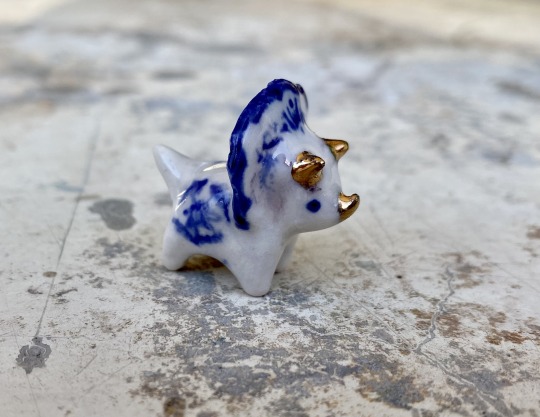

Little fucking guy alert!!
[ID: two photos of a porcelain triceratops from different angles. The triceratops is very small and has blue floral designs on its crown and body. Its three horns are painted with gold luster.]
128K notes
·
View notes
Text
Primarch Guilliman
This a part of a two portrait commission with Angron.


216 notes
·
View notes
Text
Relaxing in thr Water

Sarcosuchus! Or at least it was intended to be one, this was my first time drawing anything gator/crocodile-like, so bear with me
Anyways, someone on tiktok suggested I should draw one, so I did! I did have fun doing it. I wanted yo draw it doing that kinda funny floating thing I've seen pictures of modern gators doing, know, with their legs all like, splayed out under water
76 notes
·
View notes
Text

Tales of Earth
2. Vetulicolia
Night falls on the ancient earth. The coastal zone calms down, waiting for sunrise. But this night is special. Vetulicolias, which live solitary lives in the open ocean, return to the place where they came from. While virtually blind, they have a system of light-sensing cells that allows them to follow the patterns of the moon. And this time, the moon tells them to return to the birthplace and continue the cycle. Once enough have arrived, the females will start laying millions of eggs.
But these waters are far from safe. For predators, this is a festive dinner. Despite their carapaces, they will not be able to defend themselves from all dangers. Most of them will die where they came from. However, their strength lies in their numbers. There are not enough predators to eat all the vetulicolias, which continue to breed during the massacre. The most fortunate will be able to leave for the open ocean with the chance to return to the breeding ground once again next year.
#tales of earth#artists on tumblr#digital art#sketch#drawing#paleoart#cambrian#paleoblr#writing#speculative biology#prehistoric#chordates#vetulicolia
18 notes
·
View notes
Text




lets see if we can't make some headway on the flocking backlog... here's from a few weeks back with Triceratops, Helveticosaurus, Dickinsonia, and Melanorosaurus
697 notes
·
View notes
Text

The giants of a shallow world.
---------------------------------------------------- Ramskoeldia platyacantha is one of the largest known cambrian radiodonts at over a meter in length.
46 notes
·
View notes
Text



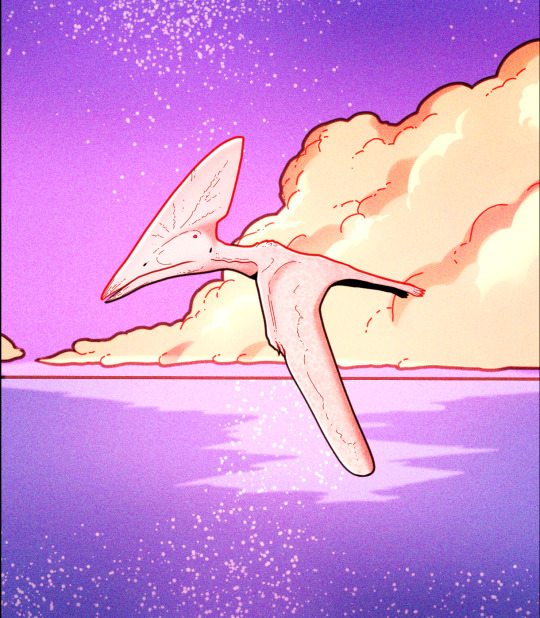

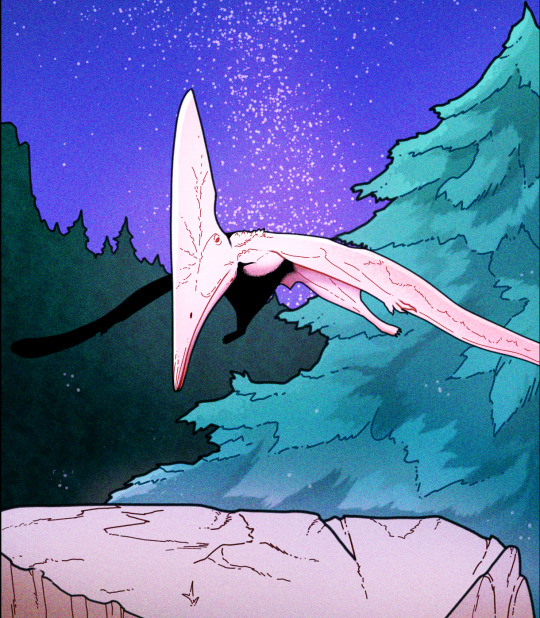




Flying Colors Ep. 1
The night we met…
Episode 1 (Current)
Episode 2
Episode 3 (To be released)
Episode 4
This is officially episode one in Flying Colors, the new narrative series featuring these characters! I liked them all so much that I turned them into a webcomic (because one webcomic wasn’t enough work…).
After I finish ep. three, I’ll continue the story in chronological order to avoid confusion. Ep. five will return us to the desert and to Socks the rhamphorhynchus.
Flying Colors is also available to read on my new homemade comics website!
I’ve gotten so many comments across socials about my pterosaurs; I read and appreciate every single one. The characters started out as silly little guys but are now so meaningful to me. I hope you’ll enjoy watching their stories come together. Thanks so much for reading my work!
406 notes
·
View notes


